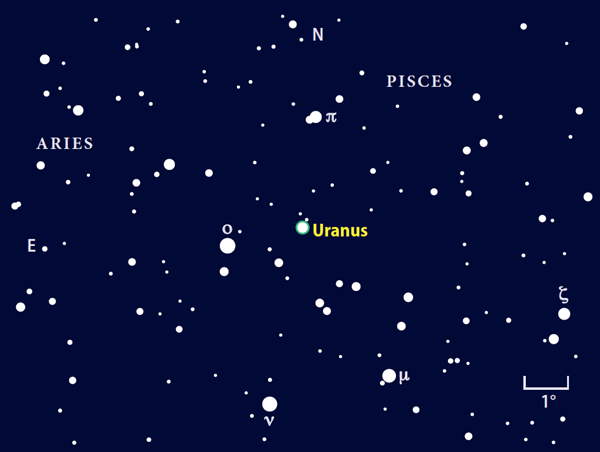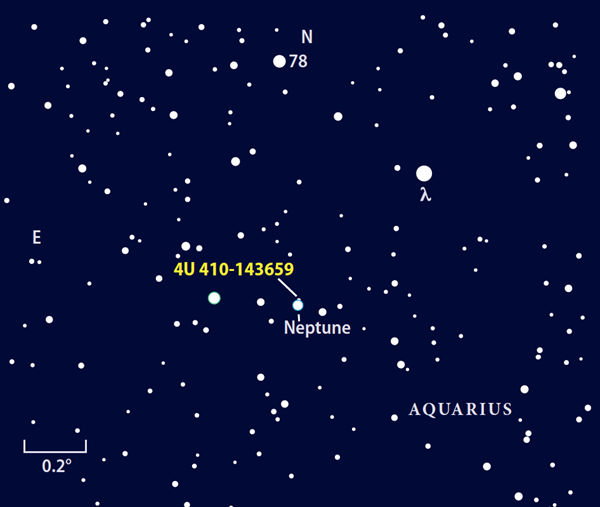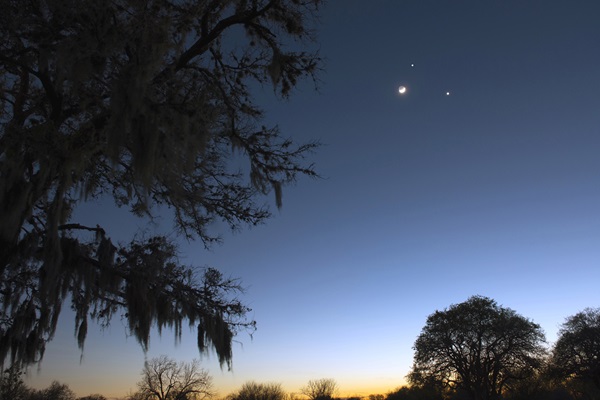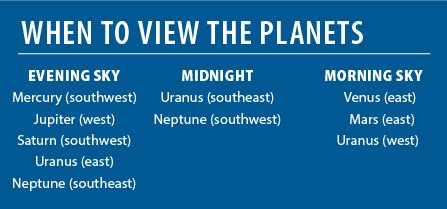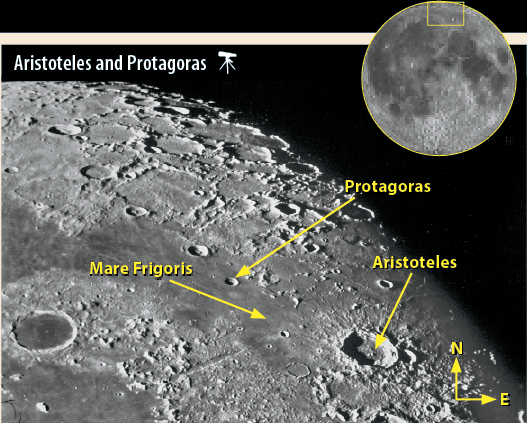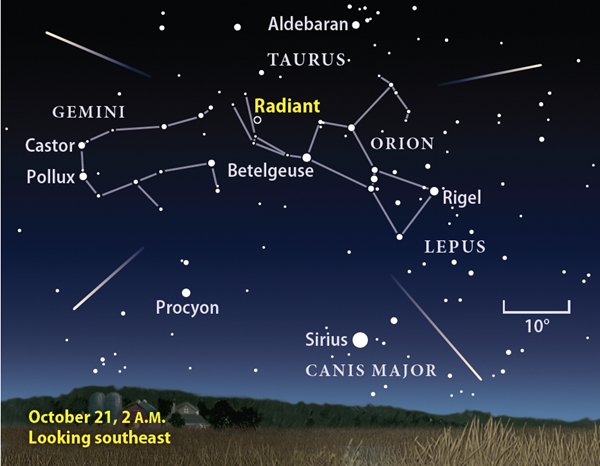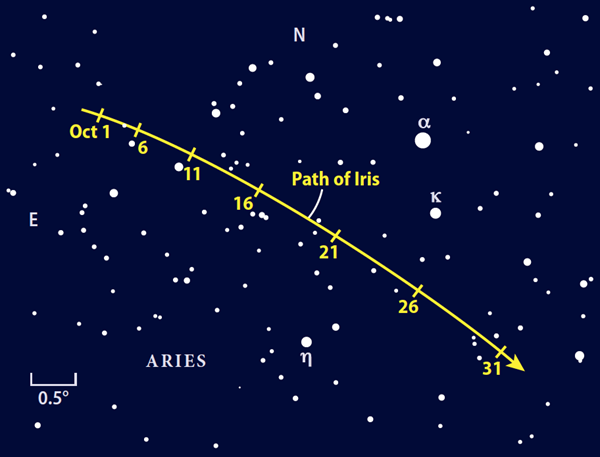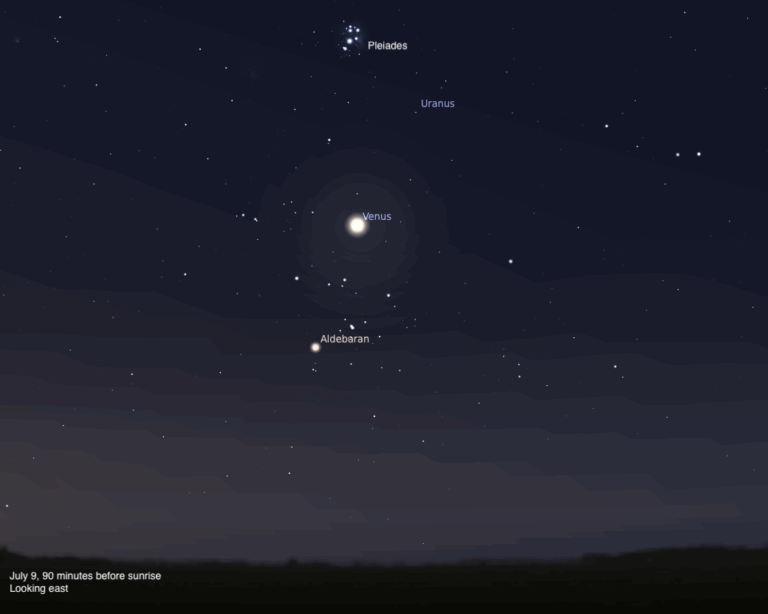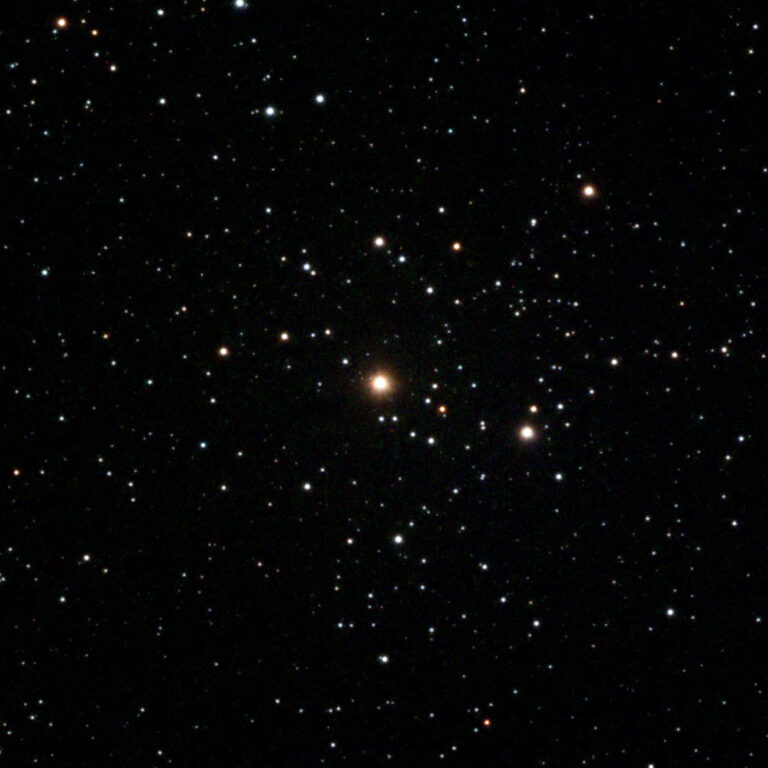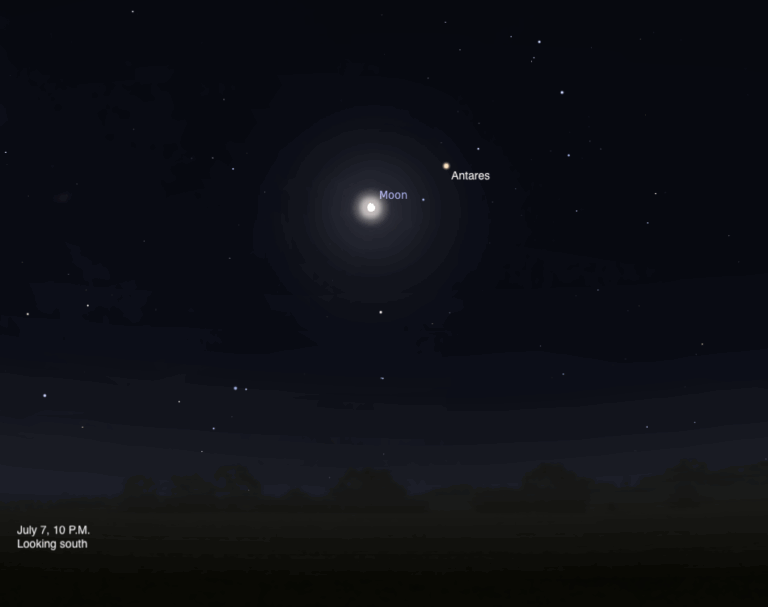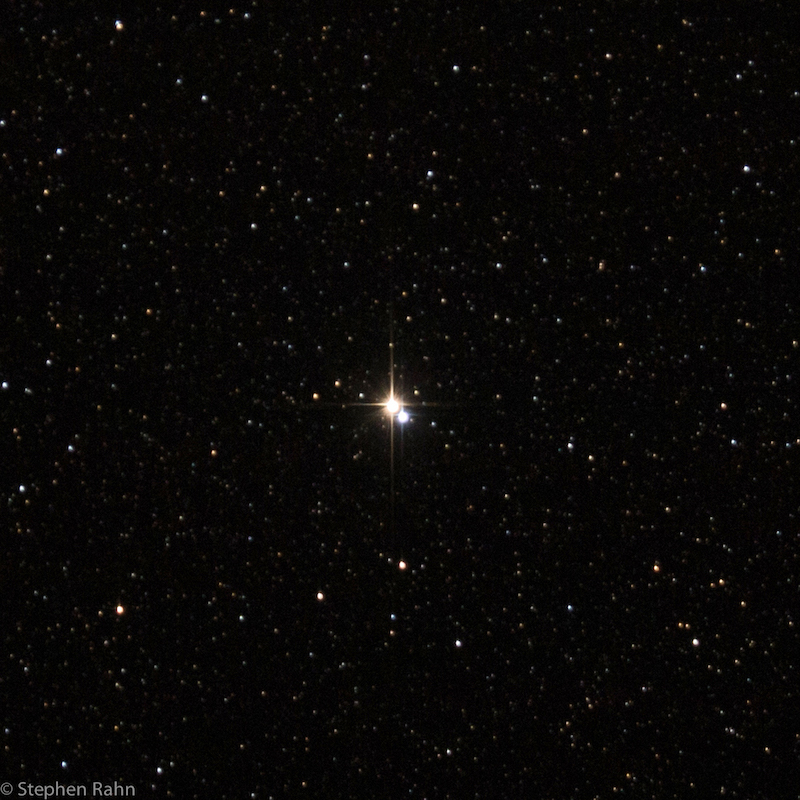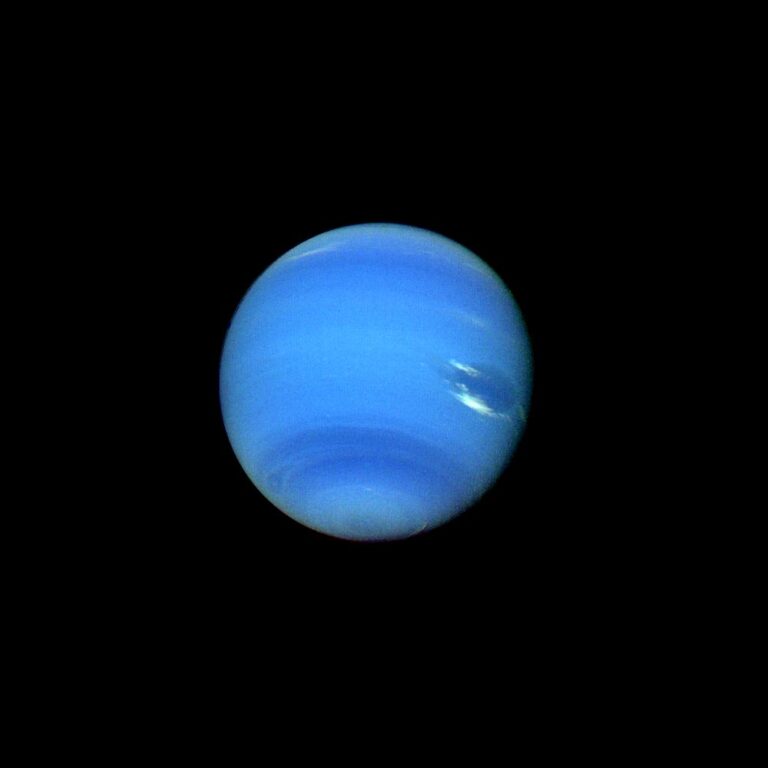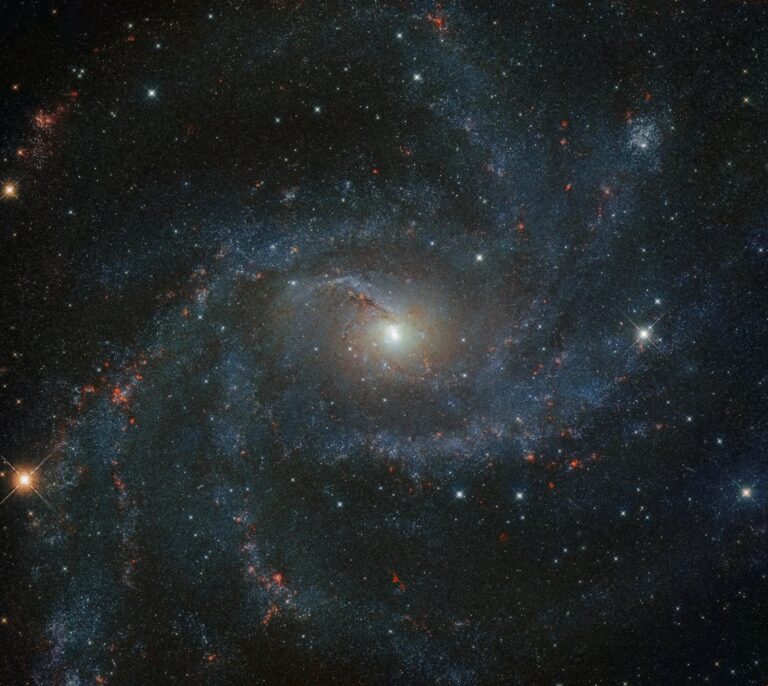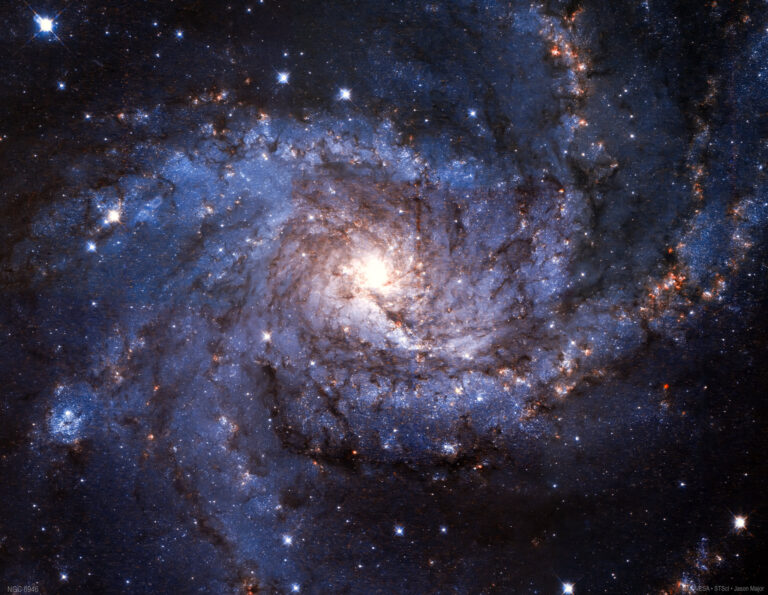Key Takeaways:
But the stars of the evening show lie even farther afield. Neptune grabs the spotlight October 5/6 when its largest moon, Triton, dramatically cuts off the light of a distant sun. And Uranus reaches opposition and peak visibility this month, making it a tempting target all night. As this planet sinks low in the west before dawn, Venus and Mars make a striking pair in the east.
Early October provides observers with their final chance to see Jupiter in the evening sky this year. Those with a clear, unobstructed western horizon can find the giant planet 3° high a half-hour after sunset. Fortunately, it’s bright — shining at magnitude –1.7 — so you can track it nearly to the horizon despite the bright twilight.
Jupiter dips lower each evening and finally succumbs to the Sun’s glare after October’s first week. It passes behind the Sun on the 26th and will reappear before dawn in early November.
Mercury plies nearly the same parcel of real estate as Jupiter. The innermost planet slides behind the Sun at superior conjunction October 8. Viewers in the southern United States and points south might glimpse Mercury in evening twilight at the end of the month. The planet then shines at magnitude –0.4 and hangs a couple of degrees high in the west-southwest 30 minutes after sunset.
After straining to see our first two targets, skygazers get some welcome relief with the appearance of Saturn. The ringed planet lies 20° above the southwestern horizon at the end of twilight in early October. Although it dips lower as the month progresses, it remains conspicuous. Saturn shines at magnitude 0.5 against the backdrop of southern Ophiuchus.
Now swing your telescope to Saturn. The planet’s disk appears 16″ across, and the rings span 36″ in mid-October. But more significantly, the ring system tilts 27.0° to our line of sight — the maximum angle possible. The rings haven’t appeared this open since 2003, and they won’t approach this tilt again until 2032.
The steep angle means observers will get superb views of ring structure. The Cassini Division — the dark gap that separates the outer A ring from the brighter B ring — will be obvious through any scope. And this will be a great chance to spot the Encke Division, a narrow, challenging feature near the A ring’s outer edge.
If you can tear yourself away from the rings, Saturn also boasts a family of bright moons. The biggest and brightest, 8th-magnitude Titan, completes a circuit of the planet once every 16 days. Look for it due south of Saturn on October 5 and 21 and due north on the 13th and 29th. It appears 1.2′ from the ringed world on those dates.
Outermost Iapetus glows at 10th magnitude when it reaches greatest western elongation October 13. It then lies 8′ from Saturn and shows up nicely through 4-inch and larger scopes. The same instrument reveals a trio of similarly bright moons — Tethys, Dione, and Rhea — that circle the planet inside Titan’s orbit.
As Saturn prepares to set, turn your attention to Neptune. This distant ice giant reached opposition and peak visibility in early September, but the view in October barely suffers in comparison. It appears in the southeast as darkness falls in early October and climbs highest in the south around 11 p.m. local daylight time. (It reaches the same position two hours earlier by month’s end.)
You should be able to identify Neptune from its position because no star in the immediate area shines as brightly. But you can remove any doubt by pointing a telescope in its direction. Only the planet shows a discernible disk, which has a diameter of 2.3″ and a distinctive blue-gray color.
Keep your scope handy for Neptune’s event of the month: On the night of October 5/6, the planet’s big moon, Triton, passes directly in front of a star. Viewers in the northeastern United States and eastern Canada can view this rare occultation on the evening of the 5th; those in the United Kingdom, western Europe, and northwestern Africa can witness it on the morning of the 6th. A 6-inch scope will show the event.
The magnitude 12.4 star, cataloged as 4U 410-143659, dims by 1.4 magnitudes as the magnitude 13.5 moon occults it. Viewers will see the star disappear for up to 161 seconds sometime between 7:44 and 8:00 p.m. EDT (23h44m and 24h00m UT), depending on their location. The finder chart above pinpoints the star.
Uranus reaches opposition October 19. It then lies directly opposite the Sun in our sky, so it remains visible all night. It also lies closest to Earth at opposition, rendering it as bright as possible. But the appearance of an outer planet changes slowly, and Uranus maintains its magnitude 5.7 peak throughout October.
The ice giant lies among the background stars of Pisces. It starts the month 1.3° northwest of magnitude 4.3 Omicron (ο) Piscium and ends the month 2.2° due west of this star. Once you locate Uranus through binoculars, set them aside and try to spot the planet with your naked eye. You should be able to from under a dark sky. A telescope reveals Uranus’ 3.7″-diameter disk and impressive blue-green color.
By the time twilight starts to paint the morning sky, Uranus dips low in the west. The action then shifts to the eastern sky, where Venus and Mars put on a marvelous show. On October 1, they appear 2.5° apart against the background stars of Leo. Magnitude –3.9 Venus rises 13 minutes before magnitude 1.8 Mars.
The gap between the two closes until October 5, when just 0.2° — about half the Full Moon’s diameter — separates them. The two haven’t been this close since November 1995. If you view the pair through binoculars, you’ll also notice the 4th-magnitude star Sigma (σ) Leonis 0.3° north of Venus. Unfortunately, a telescope doesn’t add much. Venus spans 11″ while Mars measures 4″ across, and both appear nearly full.
The two planets move eastward relative to the background stars during October, with Venus in its inner orbit moving faster. It crosses the border into Virgo on the 9th, setting up a string of close stellar conjunctions. The bright planet passes 0.8° northeast of 4th-magnitude Beta (β) Virginis on October 12, 0.2° north of 4th-magnitude Eta (η) Vir on the 18th, 1.3° southwest of 3rd-magnitude Gamma (γ) Vir on the 22nd, and 0.3° south of 4th-magnitude Theta Vir on the 29th. By the 31st, Venus stands 16° east of Mars.
The Red Planet runs a similar gauntlet, but at a slower pace. It crosses into Virgo on October 12 before sliding 0.5° north of Beta Vir on the 18th. On the 30th, it lies 0.3° southwest of Eta Vir and nearly on top of 6th-magnitude 13 Vir. As twilight begins on the East Coast, they lie just 44″ apart; from the West Coast, 4.2′ separate the two.
But the most spectacular conjunction takes place when the waning crescent Moon passes the two planets just after midmonth. On October 17, the 5-percent-lit crescent Moon stands 2° to Mars’ left and 6° above Venus. Our satellite is much harder to see the following morning, when it appears only 2 percent illuminated and 6° to Venus’ lower left.
Most skywatchers observe during the evening and shun the morning hours except for special events. That’s why lunar observers tend to focus on the Moon’s waxing phases visible after sunset and ignore the waning phases best seen before dawn. But this month provides a nice opportunity to view the waning gibbous Moon before midnight. You might be surprised at what the different lighting reveals.
arget Luna around 11 p.m. local daylight time October 9. As you scan along the terminator — the dividing line between day and night — features may look odd because you’re viewing lunar sunset and not sunrise. The reverse lighting makes it easy to see the relationship between the snaking Serpentine Ridge and Mare Serenitatis.
From there, jump halfway to the pole and find the large crater Aristoteles. The low Sun angle transforms its apron of impact splatter into a finely textured expanse. Check out the shadow cutting across Aristoteles’ middle and trace the huge “divot” of light back to the small crater that breaches the western flank and allows sunlight to reach the floor.
Farther to the northwest lies the crater Protagoras, which resembles a golf hole in the putting green formed by the solidified lava of Mare Frigoris. Normal craters are surrounded by a raised rim whose western flank glows brightly in the setting Sun. But an ancient lava flow came right up to the western lip of Protagoras, so there’s no rim to catch the Sun’s rays. Under the more familiar lighting conditions of a waxing crescent Moon on the evening of October 25, you might never suspect this unusual feature was hiding in plain sight.
The shadows intensify on the 10th as the Sun drops lower in the lunar sky, though the Moon doesn’t climb to a decent altitude until midnight.
Halley’s Comet last appeared in our sky more than 30 years ago, but it still makes its presence known. Every October, Earth plows into debris left behind by the periodic comet during its trips through the inner solar system. As this dusty debris burns up in our atmosphere, we see flashes of light known as meteors. The flashes appear to radiate from the constellation Orion the Hunter, which lends its name to the Orionid meteor shower.
Conditions this year should be ideal. The shower peaks before dawn October 21, just two days after New Moon. Observers under a dark sky can expect to see close to the maximum rate of 20 meteors per hour in the hours before dawn.
For the past two months, Comet PANSTARRS (C/2015 ER61) has been floating near the Pleiades star cluster (M45), or Seven Sisters, in northwestern Taurus. They remain neighbors during October, though PANSTARRS’ slow westward motion carries it into eastern Aries by the month’s final week. The solar system object should glow around 11th magnitude as it heads back toward the distant Oort Cloud from which it came. That brightness pushes the limits of a 4-inch telescope under a dark sky, but should pose little problem through an 8-inch or larger instrument.
You’ll want to avoid viewing during October’s first 10 days, when a bright Moon shares the evening sky. The two-week window of dark skies that follows should be ideal. PANSTARRS then appears some 30° above the eastern horizon at 11 p.m. local daylight time.
Apart from sharing the same area of sky, the comet and Pleiades showcase a common phenomenon of physics: light scattering (or reflecting) off dust. Comet dust arises when sunlight turns the ices on the body’s nucleus directly into a gas, and carries dust away in the process. These particles form a shroud around the nucleus that appears yellow because it reflects sunlight. Far in the background, the Pleiades’ stars are plowing through a cloud of cosmic dust. These particles scatter the blue light radiated by the cluster’s many hot, young stars.
As Comet PANSTARRS moves steadily away from the Sun, its dust production is dropping with each passing night. Through most telescopes, it likely will look like an unimpressive elliptical galaxy — mostly round and a bit brighter toward the center. The comet’s small size and low surface brightness mean you might not see this structure at first under low power, but at 120x or more, it should show quite nicely.
The space between the orbits of Mars and Jupiter is packed with hundreds of thousands of small bodies known as asteroids. Only a handful of these objects are big enough and come close enough to Earth to show up easily through binoculars. Fortunately, October’s sky features a fine specimen of this rare breed.
Asteroid 7 Iris ranks second only to 4 Vesta as the brightest asteroid of 2017. Iris glows at magnitude 6.9 when it reaches opposition and peak visibility late this month. Eagle-eyed observers under pitch-black skies might be able to glimpse it with their naked eye, but even newcomers should have little trouble finding it through binoculars from the suburbs.
Iris lies within one binocular field of Aries the Ram’s brightest star — magnitude 2.0 Hamal (Alpha [α] Arietis) — all month. This area stands high in the east by midevening. Simply walk outside, dark adapt for five minutes, and then focus in on Hamal.
The easiest time to find Iris comes during October’s final week, when it shines brightest and slides 1.7° due south of Hamal and 1.0° due south of magnitude 5.0 Kappa (κ) Ari. To confirm a sighting, sketch the field with Alpha, Kappa, and several of the stars near the asteroid’s position plotted below. Return a night or two later and identify the point of light that changed position. That “star” is Iris.


